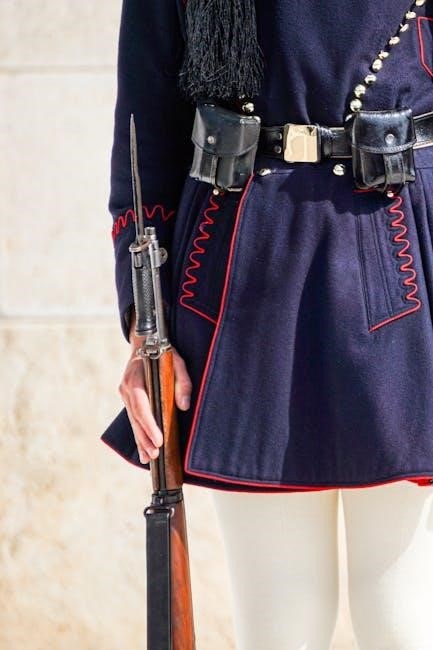
The Honor Guard Manual PDF serves as a comprehensive guide, detailing ceremonial protocols, uniform standards, and training procedures for honor guard members. It ensures precision and respect in ceremonies.
1.1 Overview of the Honor Guard Manual
The Honor Guard Manual is a detailed guide outlining protocols, procedures, and traditions for honor guard units. It covers ceremonial drill movements, uniform standards, and funeral service etiquette. The manual emphasizes the historical significance of honor guards, tracing their origins in military traditions. It also provides insights into the evolution of ceremonies and the role of honor guards in representing national pride. Designed for military, veteran, and first-responder groups, the manual ensures consistency and professionalism in ceremonies. It serves as a foundational resource for training, maintaining discipline, and upholding the dignity of honor guard traditions.
1.2 Importance of the Manual for Honor Guard Members
The Honor Guard Manual is essential for members, providing clear guidelines on ceremonial procedures, uniform standards, and drill movements. It ensures uniformity and professionalism in executions, preserving the dignity of honor guard traditions. The manual aids in training, helping members master key skills and protocols. It also serves as a reference for maintaining discipline and respect during ceremonies. By adhering to the manual, honor guard members uphold national pride and honor those they serve. Its comprehensive nature makes it indispensable for both new and experienced members, fostering excellence in every detail of their duties.
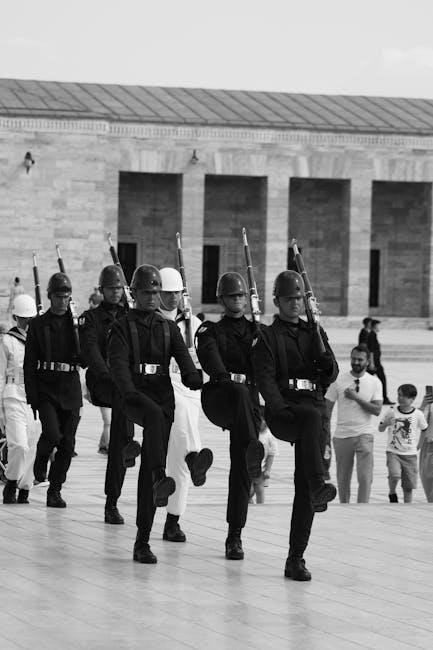
Historical Background of Honor Guards
Honor guards trace their origins to early military traditions, symbolizing discipline and respect. They originally served as protective units, evolving into ceremonial symbols of national pride and solemnity.
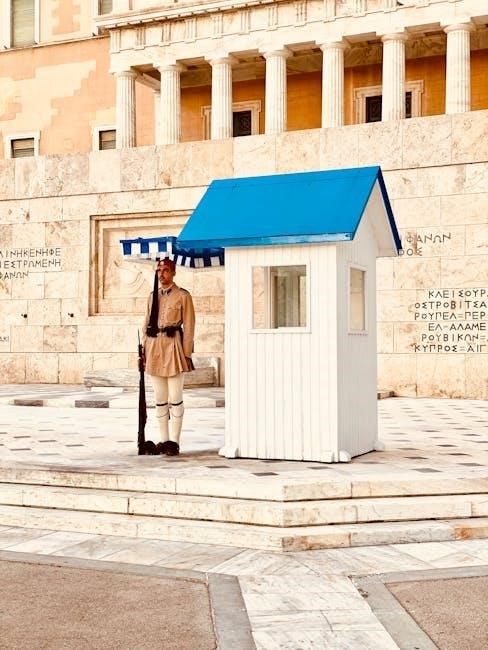
2.1 Origins of Honor Guards in Military Traditions
The origins of honor guards can be traced back to early military practices, where they served as elite protective units for high-ranking officials and symbolic representations of discipline. In the Continental Army, honor guards were used to demonstrate improved military organization and respect. These units gradually evolved into ceremonial entities, showcasing national pride and solemnity. Their historical role laid the foundation for modern honor guard protocols, emphasizing precision and reverence in ceremonies. This tradition continues to be upheld, honoring military heritage and values.
2.2 Evolution of Honor Guard Ceremonies and Protocols
Honor guard ceremonies and protocols have evolved significantly, influenced by military traditions and cultural shifts. Early practices focused on symbolic protection and discipline, while modern ceremonies emphasize precision and solemnity. The development of standardized drill movements and uniform guidelines has formalized honor guard operations. Protocols now encompass flag folding, funeral services, and memorial events, ensuring consistency and respect. The integration of these ceremonies into national and military customs highlights their enduring significance, blending historical traditions with contemporary practices to honor individuals and institutions with dignity and precision.
Structure and Content of the Honor Guard Manual
The Honor Guard Manual is organized into chapters covering drill movements, uniform standards, and ceremonial protocols, providing a detailed guide for members to master honor guard traditions effectively.
3.1 Chapters and Key Sections of the Manual
The Honor Guard Manual PDF is divided into clear chapters, each addressing specific aspects of honor guard duties. Key sections include foundational history, ceremonial protocols, and member responsibilities. Detailed chapters cover drill movements, uniform standards, and equipment maintenance. Additional sections focus on safety protocols for firearms and guidelines for funeral services. Practical examples and visual aids are provided to ensure understanding. The manual also includes advanced techniques for precision and excellence in ceremonies. Every chapter is designed to equip members with the knowledge and skills needed to perform honor guard duties with dignity and professionalism, upholding the highest standards of respect and tradition.
3.2 Detailed Instructions on Ceremonial Procedures
The manual provides step-by-step guidance for executing ceremonies with precision. It outlines procedures for flag folding, funeral services, and memorial events, ensuring respect and dignity. Detailed instructions cover proper drill movements, rifle handling, and uniform protocols. Specific sequences for ceremonies, such as the presentation of colors and the firing of volleys, are clearly explained. Practical examples and visual aids enhance understanding, while emphasizing adherence to tradition and protocol. This section equips honor guard members with the knowledge to perform ceremonies flawlessly, honoring the legacy of those being recognized. Every detail is designed to uphold the highest standards of respect and professionalism.
Role and Significance of the Honor Guard
The Honor Guard represents military and national pride, conducting ceremonies with precision and dignity. Their role is to honor individuals, uphold traditions, and inspire unity through symbolic actions.
4.1 Representation of Military and National Pride
The Honor Guard embodies military and national pride, showcasing discipline and respect through precise ceremonies. Their presence at funerals, memorials, and state events symbolizes gratitude and patriotism. By upholding traditions, they inspire unity and honor the sacrifices of service members. The manual emphasizes the importance of their role in representing the nation’s values and heritage. Their actions reflect the highest standards of professionalism, ensuring ceremonies are conducted with dignity and respect. This representation fosters a sense of national identity and pride, both for the military and the community they serve;
4.2 Role in Funeral Services and Memorial Events
Honor guards play a vital role in funeral services and memorial events, ensuring dignity and respect for deceased service members. They perform ceremonies such as flag folding, rifle salutes, and pallbearer duties. These rituals provide comfort to grieving families and honor the sacrifices of veterans. The manual outlines precise protocols for these events, emphasizing the importance of professionalism and unity. By adhering to traditional ceremonies, honor guards create a meaningful tribute, offering closure and recognition of a service member’s dedication to their country.
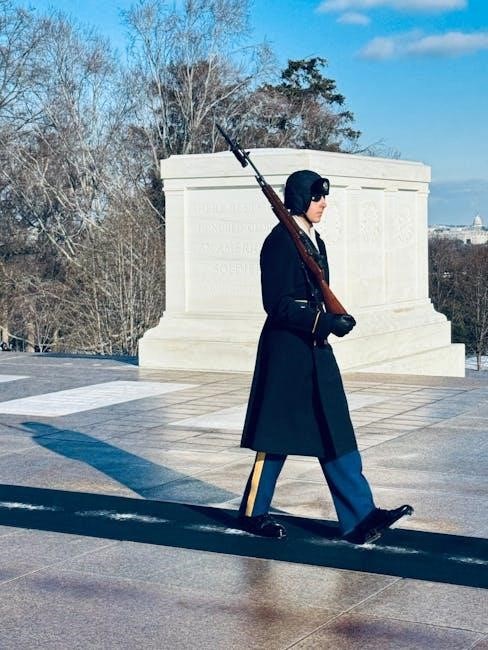
Training and Preparation for Honor Guard Members
Honor guard members undergo rigorous training to master drill movements, ceremonial protocols, and uniform standards. The manual provides detailed guidance to ensure precision and professionalism in every performance.
5.1 Foundational Skills and Drill Movements
Foundational skills for honor guard members include mastering the manual of arms, precise facing movements, and synchronized drill techniques; These skills are essential for maintaining uniformity and professionalism during ceremonies. The manual emphasizes the importance of practice to ensure flawless execution of rifle handling, flag folding, and other ceremonial protocols. Proper posture, alignment, and coordination are also critical components of the training. By perfecting these fundamental movements, honor guard members uphold the dignity and tradition of their role in military and national ceremonies.
5;2 Advanced Techniques for Ceremonial Excellence
Advanced techniques in the Honor Guard Manual PDF focus on refining precision and synchronization in drill movements. Members learn complex rifle maneuvers, such as synchronized spins and tosses, to enhance ceremonial impact. The manual emphasizes perfecting these skills through repetitive practice and attention to detail. Advanced firearm handling, including ceremonial firing protocols, is also covered. These techniques ensure that honor guard members consistently deliver polished performances, reflecting the highest standards of professionalism and respect during ceremonies and events. Mastery of these advanced methods is crucial for upholding the dignity and tradition of honor guard ceremonies.
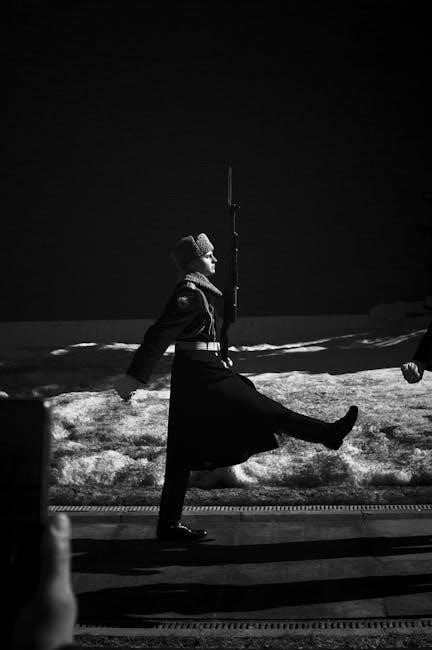
Uniforms and Equipment Specifications
The Honor Guard Manual PDF outlines standardized uniforms and equipment specifications, ensuring adherence to strict military and ceremonial standards. It covers detailed guidelines for maintenance, proper handling, and storage of all gear, ensuring a professional appearance and functionality during ceremonies.
6.1 Standardized Uniforms for Honor Guard Units
The Honor Guard Manual PDF emphasizes the importance of standardized uniforms, ensuring a cohesive and professional appearance. These uniforms are designed to reflect military and national pride, with specific guidelines for fabric, color, and tailoring. Details such as insignia placement, ribbons, and headwear are meticulously outlined to maintain uniformity across all units. The manual also provides specifications for seasonal and ceremonial variations, ensuring appropriateness for different events. Proper fit and maintenance are stressed to uphold the dignity of the honor guard role. This section serves as a definitive guide for unit members to present themselves with precision and honor.
6.2 Equipment Maintenance and Handling Guidelines
The Honor Guard Manual PDF provides detailed guidelines for the maintenance and handling of equipment, ensuring longevity and functionality. Proper cleaning schedules, storage protocols, and inspection processes are outlined to prevent damage. Members are instructed on the safe handling of firearms, flags, and ceremonial items, emphasizing preventative maintenance. Regular checks ensure equipment is in optimal condition for ceremonies. Adherence to these guidelines guarantees the honor guard’s equipment remains respectful and serviceable, reflecting the unit’s professionalism and dedication to tradition. This section is crucial for upholding the dignity of ceremonial duties.
Ceremonial Procedures and Protocols
The Honor Guard Manual PDF outlines standardized protocols for ceremonies, ensuring precision and respect. It covers flag folding, presentation ceremonies, and funeral etiquette, guiding members through solemn events with dignity.
7.1 Flag Folding and Presentation Ceremonies
The Honor Guard Manual PDF provides detailed instructions for flag folding, a symbolic ceremony often performed during funerals and memorial services. Each fold carries specific meaning, with the traditional 13 folds representing patriotism, freedom, and respect. The manual outlines precise steps for folding the American flag, ensuring accuracy and dignity. It also covers proper presentation techniques, emphasizing the importance of maintaining solemnity and respect during ceremonies. Clear photos and diagrams accompany the instructions, making it easier for honor guard members to master this sacred ritual. The guide ensures uniformity in execution across all honor guard units.
7.2 Funeral and Memorial Service Etiquette
The Honor Guard Manual PDF outlines proper etiquette for funeral and memorial services, ensuring respect and dignity for the deceased and their families. It emphasizes the importance of maintaining composure, wearing appropriate attire, and following ceremonial protocols. The manual provides guidance on coordinating with funeral directors, arranging formations, and executing precise movements. It also includes procedures for presenting condolences and managing ceremonial elements such as flag displays and floral tributes. These guidelines ensure honor guard members uphold the highest standards of professionalism and reverence during solemn occasions. The manual serves as a vital resource for honoring fallen heroes with utmost respect and precision.
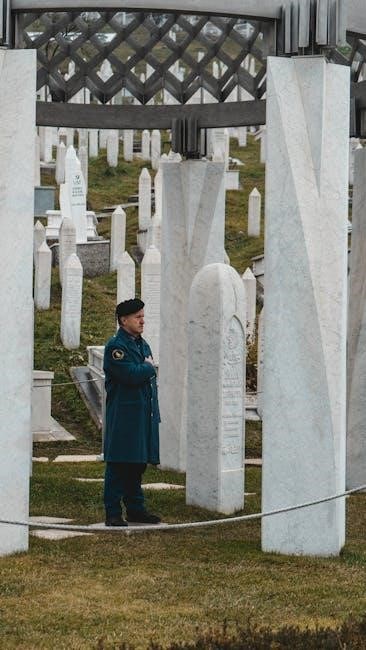
Safety and Handling of Firearms
The Honor Guard Manual PDF emphasizes strict safety protocols for firearm handling, including proper inspections, storage, and training to prevent accidents during ceremonies and drills.
8.1 Proper Handling and Safety Measures
The Honor Guard Manual PDF outlines strict safety protocols for firearm handling, emphasizing mandatory safety training, proper trigger control, and securing weapons. Members must ensure muzzles remain pointed in safe directions, and fingers are off triggers until firing. Regular inspections of firearms are required to prevent malfunctions. The manual also stresses the importance of storing firearms securely when not in use. These measures ensure safety during ceremonies, drills, and transport, upholding the honor guard’s professionalism and responsibility. Proper handling techniques are non-negotiable to prevent accidents and maintain public trust.
8.2 Regulations for Ceremonial Firearm Use
The Honor Guard Manual PDF establishes clear regulations for ceremonial firearm use, ensuring adherence to safety and tradition. These regulations include the use of blank ammunition only, strict authorization protocols, and mandatory supervision by experienced personnel. Firearms must be inspected prior to ceremonies, and members are prohibited from carrying live rounds. The manual emphasizes the importance of following all local, state, and federal laws regarding firearm use in ceremonial contexts. Proper handling and adherence to these regulations are critical to maintaining the dignity and safety of honor guard ceremonies, balancing tradition with responsibility.
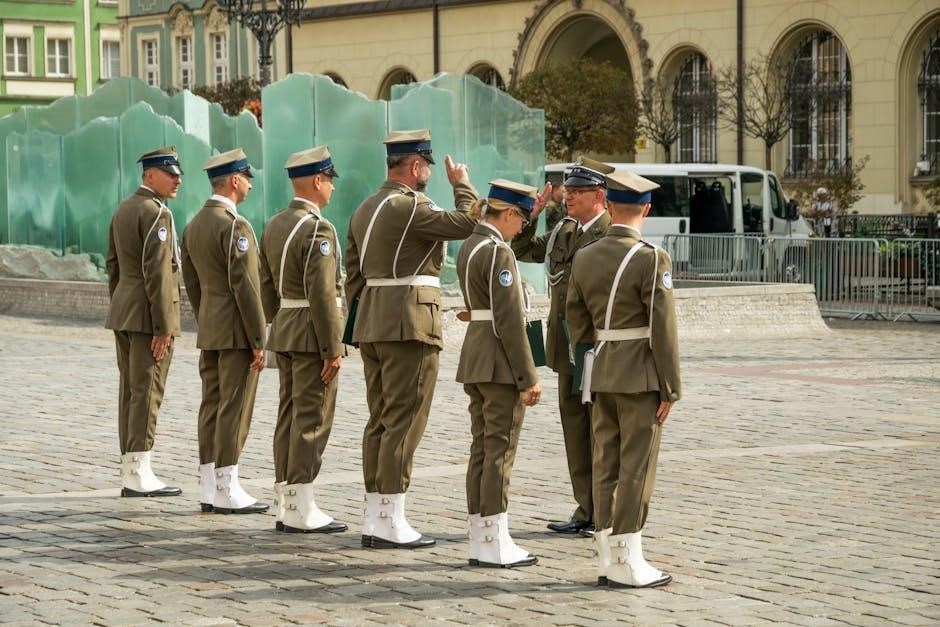
Case Studies and Real-World Applications
The Honor Guard Manual PDF highlights real-world examples, showcasing honor guard participation in national events and funeral services, demonstrating their critical role in honoring veterans and upholding traditions.
9.1 Examples of Honor Guard Participation in National Events
The Honor Guard Manual PDF illustrates their significant role in national ceremonies, such as the Kentucky National Guard honoring a Medal of Honor recipient whose grave was unmarked for 148 years. Additionally, the Gaston County Honor Guard has provided funeral services for veterans, showcasing their dedication to honoring fallen heroes. The East Tennessee Volunteer Honor Guard, one of the largest groups, coordinates funeral services and ceremonies for military families, demonstrating their commitment to national pride and solemn traditions. These examples highlight the Honor Guard’s vital presence in upholding respect and dignity during cherished events.
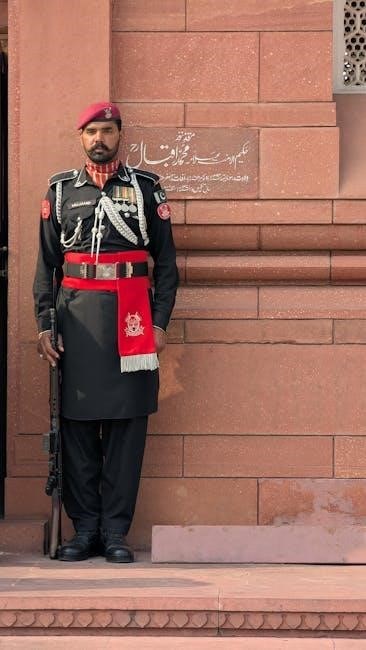
9.2 Stories of Honor Guard Units Making an Impact
The Gaston County Honor Guard, formed in 2011, has profoundly impacted their community by providing funeral services for honorably discharged veterans, ensuring they receive the respect they deserve. The Kentucky National Guard’s Honor Guard made history by honoring a Medal of Honor recipient whose grave was unmarked for 148 years, restoring dignity to his legacy. Similarly, the East Tennessee Volunteer Honor Guard, one of the largest groups, has supported countless military families through coordinated funeral services and eulogies, exemplifying their dedication to honoring fallen heroes and upholding national pride.
Budgeting and Resource Management
Effective budgeting strategies ensure Honor Guard operations are well-funded, with resources allocated for training, equipment, and ceremonies, guaranteeing efficient management and sustainable activities.
10.1 Allocating Resources for Honor Guard Operations
Allocating resources for Honor Guard operations involves strategic planning to ensure funds are distributed efficiently across training, equipment, and ceremonial events. Budgets must cover uniform maintenance, firearm safety equipment, and travel expenses for members. Additionally, resources should be allocated for professional development, such as advanced drill techniques and etiquette workshops. Proper financial management ensures that all activities align with the Honor Guard’s mission to represent national pride and honor fallen heroes with dignity and precision.
10.2 Fundraising Strategies for Honor Guard Units
Fundraising is crucial for Honor Guard units to sustain operations and ceremonies. Strategies include organizing community events, seeking corporate sponsorships, and applying for grants from veteran organizations. Online campaigns and merchandise sales, such as branded apparel, can also generate funds; Partnering with local businesses for donations or sponsorships is another effective method. Additionally, hosting charity runs, auctions, or commemorative dinners can engage the public while raising resources. Transparency in financial reporting ensures trust and accountability, fostering continued support for the Honor Guard’s mission to honor veterans and national pride.
Etiquette and Conduct for Honor Guard Members
Honor Guard members must uphold the highest standards of professionalism, respect, and discipline. Their conduct reflects the dignity of the unit and the ceremonies they represent.
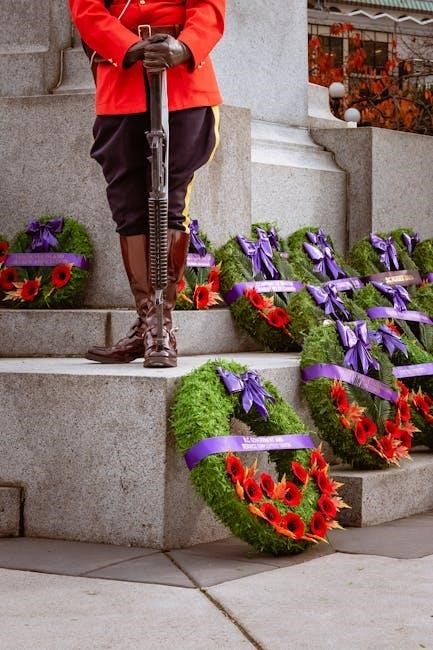
11.1 Behavioral Expectations and Code of Conduct
The Honor Guard Manual outlines strict behavioral expectations, emphasizing respect, discipline, and professionalism. Members are required to adhere to a code of conduct that upholds the dignity of the unit and the ceremonies they participate in. This includes maintaining proper posture, following commands without hesitation, and exhibiting courtesy to colleagues and the public. Adherence to these standards ensures the honor guard maintains its reputation for excellence and reverence in all events, from funerals to national ceremonies. Proper conduct is non-negotiable and essential to the unit’s mission.
11.2 Maintaining Professionalism in Ceremonial Settings
Maintaining professionalism in ceremonial settings is crucial for honor guard members. This includes conducting oneself with dignity, ensuring proper handling of equipment, and upholding decorum during events. Members must remain composed, avoiding distractions, and adhere to dress codes. Proper etiquette, such as saluting correctly and standing at attention, is essential. Professionalism reflects respect for the occasion, the honoree, and the unit. By adhering to these standards, honor guard members embody the values of discipline and reverence, ensuring ceremonies are executed with the highest level of integrity and precision.
The Honor Guard Manual PDF is a vital resource, ensuring ceremonies are conducted with respect and precision. It guides members in upholding traditions and excellence.
12.1 Summary of Key Points
The Honor Guard Manual PDF provides a detailed guide for members, covering historical background, ceremonial protocols, training, and uniform standards. It emphasizes the significance of precision, respect, and tradition in honor guard duties. The manual also addresses safety measures, budget management, and etiquette, ensuring comprehensive preparation for members. By balancing historical context with practical instructions, the manual serves as an indispensable resource for maintaining excellence in honor guard ceremonies and operations, reflecting the pride and professionalism of those who serve.
12.2 Final Thoughts on the Honor Guard Manual PDF
The Honor Guard Manual PDF stands as an essential resource for members, blending tradition with practical guidance. It equips individuals with the knowledge to perform ceremonies with precision and respect. By addressing uniforms, safety, and budgeting, the manual ensures comprehensive preparation. Its focus on professionalism and dedication highlights the honor guard’s vital role in commemorating service and sacrifice. This guide not only informs but also inspires, fostering a deeper understanding of the significance behind every ceremony and the pride it represents.
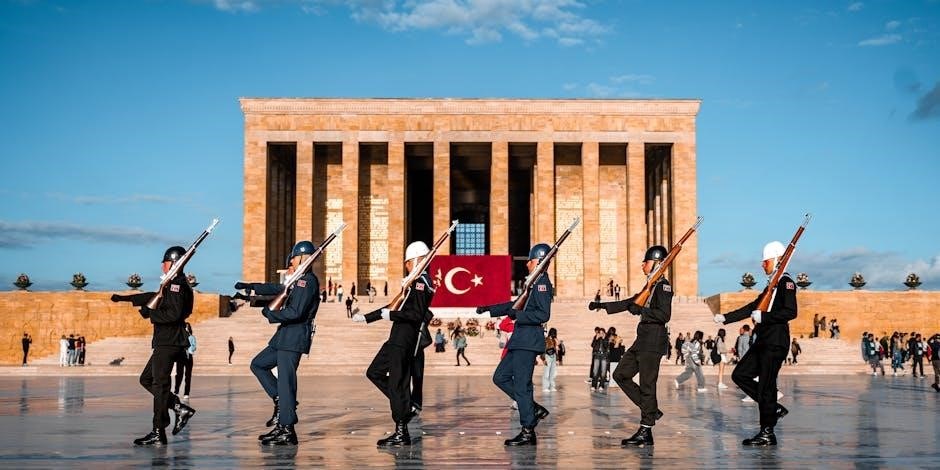
References and Further Reading
Key resources include AFMAN 36-2203, CAPP 52-8, and the Marine Corps Drill Manual. Additional guides from the American Legion and Honor Guard training manuals are recommended.
13.1 Recommended Resources for Honor Guard Members
Key resources include the AFMAN 36-2203 Drill and Ceremonies manual, CAPP 52-8 for Civil Air Patrol procedures, and the Marine Corps Drill Manual. The DrillMasters book series provides detailed ceremonial movements. Additional resources like the American Legion Honor Guard Manual and online training materials offer practical guidance. These resources cover foundational skills, ceremonial protocols, and uniform standards, ensuring comprehensive preparation for honor guard duties. They are essential for both new and experienced members to uphold traditions and excellence in service.
13.2 Links to Additional Training Materials
Additional training materials are available online, including the USAF Honor Guard Visual Guide and DrillMaster resources. Official military websites offer PDF guides and instructional videos. The Marine Corps Drill Manual and Civil Air Patrol’s CAPP 52-8 provide detailed ceremonial procedures. Links to these materials ensure access to comprehensive training tools, covering drill movements, uniform standards, and ceremonial protocols. These resources are invaluable for both initial training and ongoing professional development, helping honor guard members maintain excellence in their duties and uphold traditions with precision and respect.




